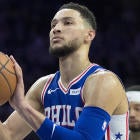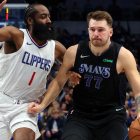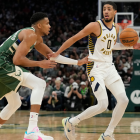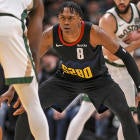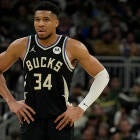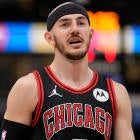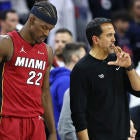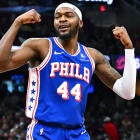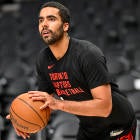Philadelphia 76ers All-Star guard Ben Simmons does so many things well on a basketball court. He's lethal in the open court and possesses pinpoint, precision passing and uncanny court vision. He's an excellent rebounder and an above-average defender, with the potential to be an elite one. He's also an unbelievable athlete with an elevated basketball IQ.
Still, critics tend to focus on the one glaring deficiency in Simmons' game up to this point in his career: his inability to stretch the floor with his shot.
In a league that is placing continued importance on the long-ball for all positions, the fact that Simmons has yet to connect on a single 3-pointer through two seasons of his professional career (he's 0 for 17 from beyond the arc) has become somewhat of a running joke among detractors, or fans of the league in general, and it is mentioned almost invariably when the 2018 Rookie of the Year is brought up in casual conversations.
Sometimes, it seems like Simmons could drop 40-15-15 in a Sixers win, but if he failed to connect on a shot from outside of the paint, his production will be dismissed. This is clearly hyperbolic, but it works to prove a point about the way that Simmons is viewed by many.
Overall, the criticism surrounding Simmons' game is overblown, in my opinion, as he can -- and does -- still positively contribute to winning despite his limited range, but there is some truth to it. Ultimately, Simmons will indeed need to improve (dramatically) if the Sixers are going to reach their lofty ceiling in the 2019-20 season, and their full potential as a team moving forward. While Joel Embiid is already an MVP-level player when he's healthy, Simmons is the one member of Philadelphia's first five that can still unlock another level to his game.
For Simmons, improvement isn't confined to shooting, though it certainly starts there, but not beyond the 3-point line -- beyond the foul line. Simmons is one of the most physically gifted athletes in the NBA today, and his natural ability provides him a proclivity for getting to the rim. Once there, he absorbs a lot of contact, but he hasn't really been able to capitalize on the resulting opportunities. As a rookie, he shot just 56 percent from the foul line, and 60 percent during his second season. Ideally, you'd like to see that number get up to around 70 percent (at least), at which point defenses would have to think twice about putting him on the line -- something that doesn't happen now.
In the past, Simmons hasn't been especially confident in his own ability to convert free throws, and that has negatively impacted his game as it has caused him to play timid at times, and to shy away from the ball down the stretch of games when the Sixers need him to be in command of the offense. If Simmons can increase his free throw percentage, it will in turn boost his confidence at the line, and thus ultimately increase his aggression. Such a development would be big for the 76ers, as they need their third-year All-Star pillar to be a player that they can trust to step up down the stretch of games.
This is especially important when you consider the departure of Jimmy Butler in free agency, as Butler had assumed the role of secondary -- and at times primary -- playmaker for the Sixers by the time the playoffs rolled around last season. Though the Sixers bounced back nicely from Butler's exit by receiving Josh Richardson in a sign-and-trade with the Heat, and then signing Al Horford with the money that would have gone to Butler, neither Richardson nor Horford is the type of perimeter initiator that Butler is, meaning that responsibility bounces back to Simmons.
Additionally, once he builds confidence from the free-throw line, one would think that that confidence could then extend outwards to the elbow and foul line-extended areas. A reliable midrange jumper that defenses had to respect would open things up tremendously on the offensive end for Simmons, and in turn for the Sixers.
The development of a shot that he is comfortable with and increased confidence are clearly correlated for Simmons, and it is an issue that he has been addressing this offseason.
"He's in the gym religiously every day, grinding, getting better," Sixers forward Tobias Harris said last month after an extensive workout session with Simmons in L.A. "He's in great shape … He's made big improvements on his game. His jump shot is looking really good and he has the confidence to shoot … It was a good sight to see."
In addition to developing a shot and increasing aggression, there is another area where Simmons could improve for next season: taking care of the ball. Considering the fact that Simmons was tied for fifth in the entire NBA in assists per game last season (7.7), this may be nit-picking. Plus, for a player who has the ball in his hands as much as Simmons does, his career average of 3.5 turnovers per game isn't terrible, but it could be better, and it will likely improve as Simmons becomes more seasoned in the league. Playoff games often come down to a single possession -- as the Sixers learned the hard way last spring -- and cutting out just a single turnover could ultimately be the difference between a win or a loss. Becoming a more efficient player is something that Simmons alluded to at his exit interview in May.
"I want to get better all around, become a better and more efficient player," Simmons said at the time when discussing how he wanted to improve moving forward. "There's no one individual spot. I think I want to work on everything and just continue to let my game grow."
Thanks to some shrewd salary cap work dating back to former general manager Sam Hinkie's tenure with the team, some good (or lucky, depending on how you look at it) drafting, the development of a solid culture under head coach Brett Brown, and some aggression on the open market on the part of Elton Brand, the Sixers are in position to accomplish some things that they haven't done in a quite some time, such as making it to the NBA Finals (it will be 19 years when the '20 Finals roll around), or even winning an NBA title (37 years). For the Sixers to get there, though, that growth that Simmons referred to needs to occur.













